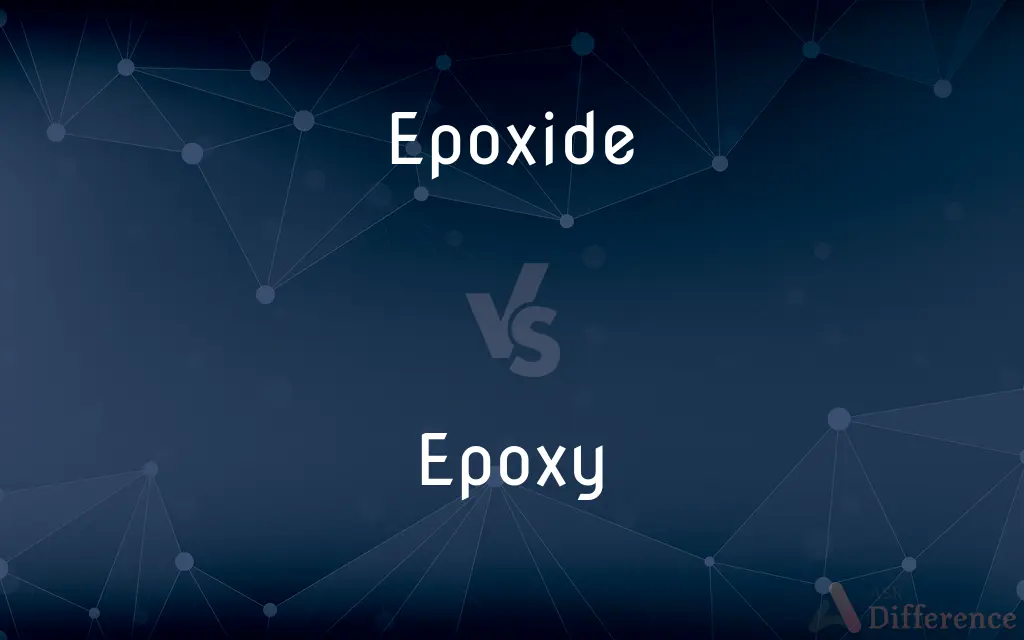Epoxide vs. Epoxy — What's the Difference?
Edited by Tayyaba Rehman — By Maham Liaqat — Updated on March 14, 2024
Epoxides are three-membered cyclic ethers, characterized by high reactivity, whereas epoxy refers to a broader class of materials that includes resins formed from the reaction of epoxides with other compounds.

Difference Between Epoxide and Epoxy
Table of Contents
ADVERTISEMENT
Key Differences
Epoxides, also known as oxiranes, are a group of organic compounds featuring a highly strained three-membered ring consisting of an oxygen atom and two carbon atoms. This structural strain imparts high reactivity, making them valuable in various chemical reactions. Epoxy, in contrast, denotes a larger category of materials, often thermosetting polymers, that are formed when epoxide molecules react with hardening agents, resulting in a rigid, durable plastic used in many applications from coatings to adhesives.
The high reactivity of epoxides makes them crucial intermediates in the synthesis of various organic compounds, including polymers, through reactions such as ring-opening polymerization. Epoxy resins, products of epoxides, are known for their exceptional mechanical properties, chemical resistance, and adhesion, making them ideal for use in a wide range of industrial and consumer products.
Epoxides are characterized by their epoxy group (-O-), a three-membered cyclic ether, which is highly susceptible to nucleophilic attack due to ring strain. Epoxy resins, on the other hand, are characterized by the presence of more than one epoxy group in their structure, which allows them to cross-link with hardeners to form three-dimensional networks.
In industrial and chemical processes, epoxides serve as key intermediates in the production of glycols, alcohols, and other valuable chemicals. Epoxy resins are utilized in the manufacturing of strong, durable materials used in construction, automotive, aerospace, and electronics industries, among others.
Understanding the distinction between epoxides and epoxy is crucial in chemistry and material science, as it highlights the relationship between reactive chemical intermediates and the versatile, high-performance materials they can produce.
ADVERTISEMENT
Comparison Chart
Definition
Cyclic ethers with a three-membered ring
Thermosetting polymers from epoxide reactions
Reactivity
High due to ring strain
Varies; generally stable after curing
Applications
Chemical synthesis intermediates
Adhesives, coatings, composites
Structural Feature
Three-membered ring with an oxygen atom
Contains more than one epoxy group
Uses in Industry
Production of chemicals, solvents
Construction, automotive, aerospace
Compare with Definitions
Epoxide
A cyclic ether with a three-membered ring.
Ethylene oxide is a simple epoxide used in making antifreeze.
Epoxy
A thermosetting polymer made from epoxides.
Epoxy resins are used in the production of strong adhesives.
Epoxide
Susceptible to ring-opening reactions.
Epoxides open up in the presence of nucleophiles, leading to various products.
Epoxy
Known for strong adhesion and chemical resistance.
Epoxy coatings protect metal surfaces from corrosion.
Epoxide
Used as an intermediate in organic synthesis.
Epoxides are intermediates in the production of epoxy resins.
Epoxy
Used in composites for enhanced strength.
Carbon fiber composites often use epoxy as a matrix material.
Epoxide
Characterized by high reactivity due to ring strain.
The epoxide group in glycidol is a key site for chemical reactions.
Epoxy
Hardens through a curing process.
Mixing epoxy resin with a hardener initiates a chemical reaction that leads to hardening.
Epoxide
Formed by the oxidation of alkenes.
Propylene is oxidized to form propylene oxide, a common industrial chemical.
Epoxy
Can be molded into various shapes before curing.
Epoxy is used in making molds for jewelry and art.
Epoxide
An epoxide is a cyclic ether with a three-atom ring. This ring approximates an equilateral triangle, which makes it strained, and hence highly reactive, more so than other ethers.
Epoxy
Epoxy is the family of basic components or cured end products of epoxy resins. Epoxy resins, also known as polyepoxides, are a class of reactive prepolymers and polymers which contain epoxide groups.
Epoxide
A ring-shaped organic compound consisting of an oxygen atom bonded to two other atoms, usually of carbon, that are already bonded to each other.
Epoxy
Any of various usually thermosetting resins capable of forming tight cross-linked polymer structures characterized by toughness, strong adhesion, and low shrinkage, used especially in surface coatings and adhesives.
Epoxide
A compound containing such a structure. In both senses also called epoxy.
Epoxy
See epoxide.
Epoxide
(organic chemistry) Any of a class of organic compound, cyclic ethers, having a three-membered ring; they are prepared by the selective oxidation of alkenes or by ring-closure of halohydrins; used to make plastics.
Epoxy
To fasten together with epoxy.
Epoxide
(organic chemistry) Any similar compound in which an ether linkage has been made across a larger ring.
Epoxy
(chemistry) Derived from an epoxide.
Epoxy
A thermosetting polyepoxide resin used chiefly in strong adhesives, coatings and laminates; epoxy resin.
Epoxy
To glue with epoxy.
Epoxy
A thermosetting resin; used chiefly in strong adhesives and coatings and laminates
Epoxy
Glue with epoxy;
Epoxy the shards
Common Curiosities
What is an epoxide?
An epoxide is an organic compound featuring a three-membered ring consisting of an oxygen atom and two carbon atoms, known for its high reactivity.
How is epoxy related to epoxides?
Epoxy refers to materials, typically resins, formed from the reaction of epoxide compounds with hardening agents, resulting in a durable plastic.
What are the uses of epoxides?
Epoxides are used as intermediates in the synthesis of various organic compounds, including pharmaceuticals, polymers, and solvents.
How are epoxy resins cured?
Epoxy resins are cured by adding hardeners, which initiate a chemical reaction leading to cross-linking and hardening of the material.
Why are epoxy resins so widely used?
Epoxy resins are favored for their strong adhesion, chemical resistance, and mechanical properties, making them ideal for coatings, adhesives, and composites.
How is the strength of epoxy materials measured?
The strength of epoxy materials can be measured in terms of tensile strength, compressive strength, and hardness, among other properties.
Can epoxides be found in nature?
Yes, some epoxides occur naturally, though many are synthesized for industrial and chemical applications.
What makes epoxides so reactive?
The three-membered ring structure of epoxides creates ring strain, making them highly susceptible to nucleophilic attacks.
Are all epoxy materials the same?
No, epoxy materials can vary significantly in their properties and formulations, tailored for specific applications and performance requirements.
What is the significance of the epoxy group in chemistry?
The epoxy group is crucial in organic chemistry for its reactivity, serving as a key intermediate in various chemical transformations.
Can epoxides undergo polymerization?
Yes, epoxides can undergo polymerization reactions, such as ring-opening polymerization, to form polyethers or other polymers.
Can epoxides be used in pharmaceuticals?
Yes, epoxides are important intermediates in the synthesis of several pharmaceutical compounds due to their reactive nature.
Are epoxy resins environmentally friendly?
The environmental impact of epoxy resins varies; concerns include their non-biodegradability and potential chemical hazards. Efforts are ongoing to develop more eco-friendly alternatives.
What safety precautions are necessary when working with epoxides and epoxy?
Proper safety gear, ventilation, and adherence to handling guidelines are essential due to potential toxicity and reactivity.
How are epoxides synthesized industrially?
Industrially, epoxides are often synthesized through the oxidation of alkenes using specific catalysts and conditions.
Share Your Discovery

Previous Comparison
Leek vs. Leak
Next Comparison
Ghost vs. RevenantAuthor Spotlight
Written by
Maham LiaqatEdited by
Tayyaba RehmanTayyaba Rehman is a distinguished writer, currently serving as a primary contributor to askdifference.com. As a researcher in semantics and etymology, Tayyaba's passion for the complexity of languages and their distinctions has found a perfect home on the platform. Tayyaba delves into the intricacies of language, distinguishing between commonly confused words and phrases, thereby providing clarity for readers worldwide.














































